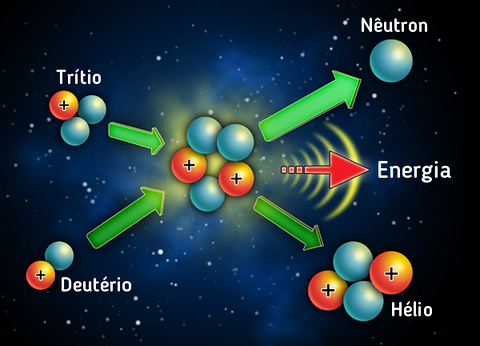Nuclear Fusion is the junctioninatomswhathascoreslight. The joining of these atoms results in an atom with a heavier nucleus.
Subjected to a very high temperature, deuterium (H2) and tritium (H3), which are isotopes of hydrogen (H), stick together. This union results in the release of a large amount of energy and helium (He) nuclei are formed.

The reaction of this process is:
About 3.108 kJ/g of energy can be released from this reaction.
The nuclear fusion process gives rise to the operation of hydrogen bombs (the most destructive atomic bombs that exist). Fusion reactions take place inside the Sun and it is the source of solar energy.
Nuclear Fusion Reactor
Nuclear fusion releases a lot of energy. For this reason, the scientific community is very committed to making nuclear energy possible as an energy option based on the fusion process.
To that end, a reactor capable of producing and controlling nuclear fusion is needed. Tokamak is the name given to reactors that are being developed in various locations around the world.
What are your Advantages?
The energy generated by nuclear fusion would be a way to guarantee safety and environmental cleanliness. That's because, the fissionnuclear produces energy mainly through uranium (one of the main radioactive elements).
Since the amount of fuel used is smaller, it follows that the radioactivity also be inferior and, therefore, the production of nuclear waste is also smaller.
The fuel used for fusion can be obtained from seawater and from the nuclear reactor's own trillium. In fission, uranium is used for this purpose, but it is not easily extracted.
Learn more about Nuclear energy.
Nuclear Fusion and the Stars
Inside stars thermonuclear reactions occur, that is, the nuclear fusion process takes place in them. The Sun is an example.
Stars are formed from hydrogen, whose core is light. The high temperature promotes fusion forming a helium nucleus, a heavier element. A lot of energy is generated in this violent process that gives energy to solar energy.
Cold Nuclear Fusion
It is a thesis of chemists Martin Fleischmann and Stanley Pons that the nuclear fusion process could happen not at very high temperatures, but at room temperature.
The hypothesis was discarded by the scientific community, as chemists could not prove that they had achieved cold nuclear fusion.
And what is Nuclear Fission?
Nuclear fission is a process that takes place just opposite to the nuclear fusion process. Instead of the fusion of atomic nuclei, what happens is their breakage.
The most used element in this process is uranium. The energy released in the reaction of at least 8.107 kJ/mol, although high, is lower than the energy obtained with nuclear fusion.
Want to know more? read Nuclear fission.
Exercises on nuclear fusion
question 1
(UFCE) The expression nuclear fusion is equivalent to:
a) liquefaction of the cores.
b) nuclear fission.
c) breakage of nuclei forming smaller nuclei.
d) gathering of nuclei forming larger nuclei.
Correct alternative: d) assembling nuclei to form larger nuclei.
In nuclear fusion atomic nuclei unite and form a larger nucleus. In this process, a neutron and a large amount of energy are also released.
question 2
(FGV-SP) On nuclear fission and nuclear fusion:
a) The terms are synonymous.
b) Nuclear fusion is responsible for producing light and heat in the sun and other stars.
c) Only nuclear fusion faces the problem of how to safely dispose of radioactive waste.
d) Nuclear fusion is currently used to produce energy commercially in many countries.
e) Both methods are still in the research phase and are not used commercially.
Correct alternative: b) Nuclear fusion is responsible for producing light and heat in the sun and other stars.
In the interior of the Sun and other stars, several fusion reactions occur due to the high temperature, which is necessary for this type of reaction to occur.
question 3
What is the difference between fission and nuclear fusion?
Answer: Nuclear fission corresponds to the splitting of an unstable atomic nucleus and formation of two more stable nuclei. In fusion, however, two nuclei unite to form a more stable nucleus.
question 4
(FEI-SP) The hydrogen bomb is an example of a nuclear reaction:
a) of the fission type.
b) where only alpha ray emission occurs.
c) where only beta ray emission occurs.
d) of the fusion type.
e) where only gamma ray emission occurs.
Correct alternative: d) Fusion type.
The hydrogen bomb contains within its interior a source that emits the isotypes of hydrogen, tritium and deuterium, which when united release a large amount of energy.
See university entrance exam questions on the subject in the list we have prepared: radioactivity exercises.


